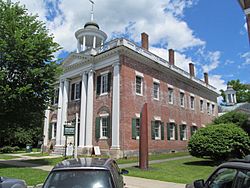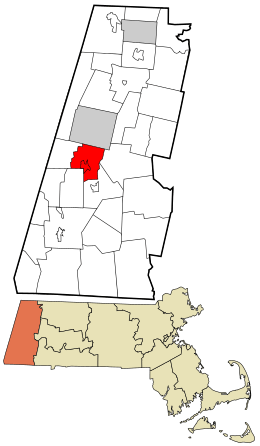Lenox, Massachusetts facts for kids
Quick facts for kids
Lenox
|
||
|---|---|---|

Library of Lenox
|
||
|
||
| Motto(s):
En La Rose, Je Fleurie (French)
"In the Rose, I Flowered" (Flourished) |
||

Location in Berkshire County and the state of Massachusetts.
|
||
| Country | United States | |
| State | Massachusetts | |
| County | Berkshire | |
| Settled | 1750 | |
| Incorporated | 1767 | |
| Government | ||
| • Type | Open town meeting | |
| Area | ||
| • Total | 21.7 sq mi (56.1 km2) | |
| • Land | 21.2 sq mi (55.0 km2) | |
| • Water | 0.5 sq mi (1.2 km2) | |
| Elevation | 1,200 ft (366 m) | |
| Population
(2020)
|
||
| • Total | 5,095 | |
| • Density | 235.22/sq mi (90.82/km2) | |
| Time zone | UTC-5 (Eastern) | |
| • Summer (DST) | UTC-4 (Eastern) | |
| ZIP Code |
01240
|
|
| Area code(s) | 413 | |
| FIPS code | 25-34970 | |
| GNIS feature ID | 0618269 | |
Lenox is a town in Berkshire County, Massachusetts, United States. It's located in Western Massachusetts and is part of the Pittsfield area. In 2020, about 5,095 people lived here.
Lenox is famous for being home to Shakespeare & Company, a theater group, and Tanglewood. Tanglewood is the summer home of the Boston Symphony Orchestra. Lenox also includes the smaller villages of New Lenox and Lenoxdale. It's a popular place for tourists to visit, especially in the summer.
Contents
History of Lenox
The area where Lenox is now was first home to the Mahican people. They spoke the Algonquian language and lived near the Hudson and Housatonic Rivers. European settlers didn't move here much until 1750. That's when Jonathan and Sarah Hinsdale started a small inn and store.
In 1761, the area became part of Berkshire County. A man named Josiah Dean bought a large piece of land that included what is now Lenox. The town was first called Richmond in 1765. But because the the Berkshires mountains split the town, a part of it called Yokuntown became its own town in 1767. It was supposed to be named Lennox, but a clerk misspelled it as Lenox.
Early jobs in Lenox included farming, working in sawmills, and making textiles. People also made potash and glass. There were even mines for iron ore under the town. In the 1780s, Job Gilbert started an iron works in Lenox Dale. Lenox was the main town for the county from 1784 until 1868. The old county courthouse, built in 1816, is now the Lenox Library.
Lenox became a popular place for artists because of its beautiful scenery. In 1821, writer Catharine Sedgwick moved here. Other famous people like Nathaniel Hawthorne also visited. When the Housatonic Railroad arrived in 1838, more and more tourists discovered the town.
Rich people from places like Boston started building large estates in Lenox. This period, from 1880 to 1920, was called the Berkshire Cottage era. Lenox became a fancy summer resort, much like Newport, Rhode Island. Wealthy families built huge houses for fun and parties during the summer. Property values went up a lot. In 1903, an acre of land in Lenox cost $20,000, which was a lot more than in nearby towns.
After 1913, it became harder to build and keep up these big mansions. Many estates were sold or torn down after the Great Depression and World War II. Some became schools or centers. For example, the Shadowbrook property is now the Kripalu yoga center. The Mount, a former estate, is now home to Shakespeare & Company.
Tanglewood, once the Tappan family's estate, became the summer home of the Boston Symphony Orchestra in 1937. Lenox is still a very popular place for tourists today. It was also used as a filming location for movies like Before and After (1996) and The Cider House Rules (1999).
Geography and Nature
Lenox covers about 56.1 square kilometers (21.7 square miles). Most of this is land, with a small part being water. Lenox is next to Pittsfield to the north and Stockbridge to the southwest. The town center is about 8 miles (13 km) south of downtown Pittsfield.
The town is divided from Richmond to the west by a part of the Berkshire Mountains. The highest point in this area is Yokun Seat, which is 654 meters (2,146 feet) tall. To the east, October Mountain rises above the Housatonic River. This river flows along the east side of town. Some parts of the river have pollution from the past.
Lenox has beautiful natural areas. These include the Pleasant Valley Wildlife Sanctuary and parts of the October Mountain State Forest. There are also several small streams that flow into the Housatonic River.
Getting Around Lenox
Major roads like Route 7 and Route 20 meet in Lenox. They head north towards Pittsfield. Massachusetts Route 7A goes through the center of town. The town center is about 5 miles (8 km) from the Massachusetts Turnpike (Interstate 90), which is a big highway.
The Housatonic Railroad also runs through Lenox. You can find Amtrak train service in Pittsfield. Buses from the Berkshire Regional Transit Authority (BRTA) also serve the town. The closest airport for regional flights is the Pittsfield Municipal Airport. For national flights, you can go to Albany International Airport in New York or Bradley International Airport in Connecticut.
Education in Lenox
Lenox has its own school system for about 800 students. Morris Elementary School teaches students from pre-kindergarten to fifth grade. Lenox Memorial Middle and High School teaches students up to twelfth grade. The high school's sports teams are called the "Millionaires." This name comes from the town's history with wealthy estates. Their colors are maroon and gold.
Lenox also has special education schools and private schools. These include Berkshire Christian, Berkshire Country Day School, and The Montessori School of the Berkshires. For college, the closest community college is Berkshire Community College in Pittsfield.
Places to Visit
Lenox has many interesting places to explore:
- Berkshire Scenic Railway Museum
- Church on the Hill
- Frelinghuysen Morris House and Studio
- Kripalu Center
- Lenox Railroad Station
- The Mount (Edith Wharton estate)
- The Museum of the Gilded Age at Ventfort Hall
- Pleasant Valley Wildlife Sanctuary
- Yokun Ridge
- Shakespeare & Company
- Tanglewood
- Ventfort Hall
- Bellefontaine
Famous People from Lenox
Many notable people have lived in or visited Lenox:
- Alice Brock, artist
- Andrew Carnegie, a very rich businessman
- Nathaniel Hawthorne, writer
- Fanny Kemble, actress and writer
- Rose Hawthorne Lathrop, social worker
- William L. Shirer, journalist and historian
- Maureen Stapleton, actress
- James Taylor, singer-songwriter
- George Westinghouse, inventor and businessman
- Edith Wharton, writer
- Finn Wittrock, actor
Images for kids
See also
 In Spanish: Lenox (Massachusetts) para niños
In Spanish: Lenox (Massachusetts) para niños











